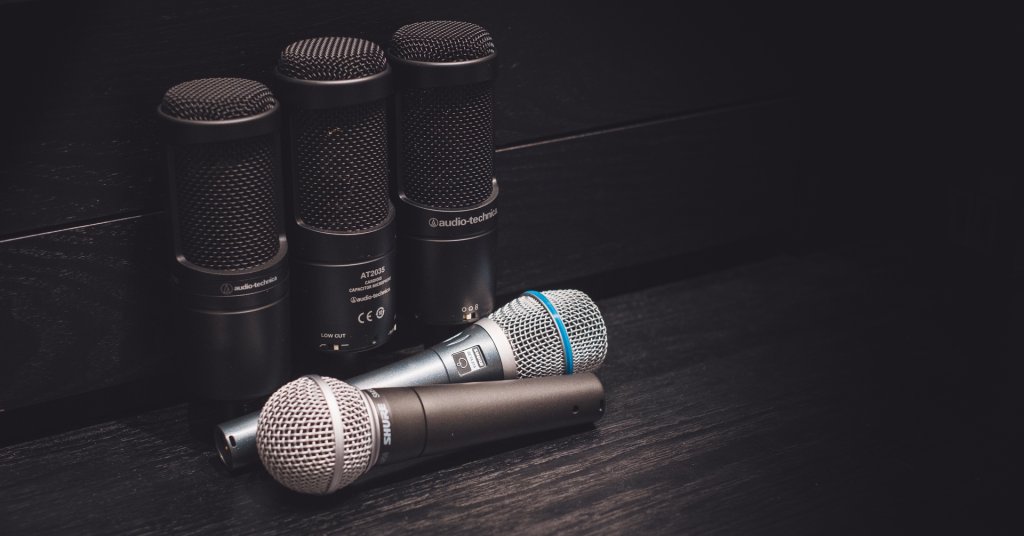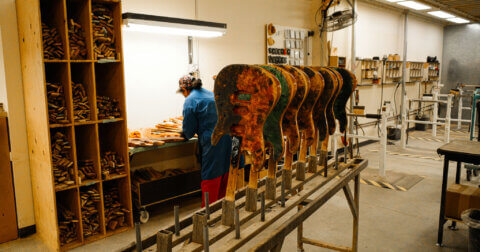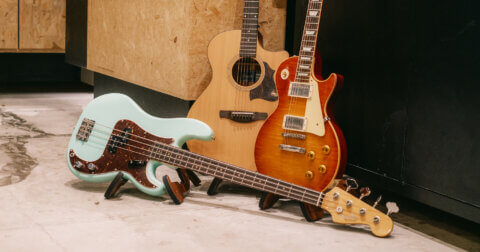Whether you’re a singer, musician, or podcaster, you’ll come across many different types of microphones when looking for one that suits your needs. The hardware and mechanics of different microphones can be confusing, but this beginner’s guide to studio microphones will help make your search easier.
While there are many types of microphones out there, we’re going to be focusing on studio microphones that are best suited for music recordings, broadcasting, and tracked live performances. Read on to find out more.
Dynamic Microphones
Dynamic microphones are one of the most common types of microphones. They are great for recording drums, percussion and booming brass instruments in the studio. As well as being durable and dependable, dynamic microphones are often cheaper than condenser microphones. The perfect choice for musicians that need things loud, these microphones are a winning purchase that won’t break the budget.

Dynamic Microphones use magnets to convert sound waves into voltage. Most dynamic microphones contain a thin, lightweight diaphragm. Sound waves vibrate the microphone’s internal diaphragm, which in turn moves a voice coil that’s suspended in a magnetic field. An electrical pulse is generated, then enhanced with an internal transformer before being finally sent to the microphone’s output.

Condenser Microphones
Condenser microphones are much more sensitive than dynamic microphones. Built for fidelity, these microphones are well equipped to pick up on subtle shifts and nuance. This makes them perfect for capturing natural tones in the studio – particularly vocals, acoustic instruments and even ambient sounds. However, we wouldn’t recommend condenser microphones for live performances because anything too loud will lead to the microphone producing a significant amount of distortion.

Similar to dynamic microphones, condenser microphones contain a diaphragm with a magnetic backplate. The difference is that a condenser microphone draws its power from an external source – just like a battery. Sound pressure vibrates the diaphragm and the microphone’s hardware generates voltage that is then passed through built-in filters and pads (which vary from model to model) before being sent to the microphone’s output.
How does diaphragm size affect condenser microphones?
Size matters in all microphones, but particularly with condenser mics and their degree of responsiveness.
Small-diaphragm Condenser Microphones
Sometimes called pencil microphones, these microphones are great at picking up higher frequencies. These builds are best used to capture a room’s ambient sounds, or when positioned near snares, pianos and acoustics for high-fidelity recordings that capture clean, detailed tones.

Large-diaphragm Condenser Microphones
Bigger diaphragm mics are more sensitive when picking up sounds, and are favoured for adding warmth and colour to recordings. On the flipside, their polar pattern is larger, and therefore less consistent when picking up off-axis sounds. For more detailed information about polar patterns and how they affect recordings, read on.

USB Microphone
USB microphones provide users with a hassle-free recording set-up. These microphones have an analogue-to-digital (A/D) converter and an in-built preamp which allows you to plug the microphone directly into a computer and have your recordings track directly into a recording software. Simply set up the microphone, start up your audio workstation of choice, and you’re good to go!

Most USB microphones are condenser mics, however there are select models of USB microphones that are dynamic microphones too. Depending on what you’re using your microphones for, dynamic USB microphones can be used for crisp, detailed recordings (ASMR, or even audiobook recordings) while condenser USB microphones are better suited for louder recordings.

One good thing about USB mics is that they don’t require phantom power. As long as the USB cable is plugged straight into a device, the microphone will draw power from that device. This cuts down on the amount of cables and wires you have around your workspace!
Lavalier microphone
The lavalier microphone goes by many names that you might find familiar – the body mic, clip mic and even personal mic. The lavalier’s hands-free build is a great alternative to hand-held or stand-mounted mics. You’ll find these small, usually clip-on microphones used by newscasters, presenters, and select sing-and-dance performers.

Polar patterns
Polar patterns are an important factor to consider when it comes to picking out microphones. A microphone’s polar or pickup pattern determines the direction and spread of sound that it’s able to capture. Most microphones are split into three polar patterns – cardioid, omnidirectional, and bidirectional.
To get a better understanding of which polar patterns best suit your needs, here are some facts you should know.
Cardioid
This microphone gets its name from its heart-shaped polar pattern, and is sometimes labelled a unidirectional microphone. Cardioid microphones are most sensitive to directional sound from their front, less so from the sides and its rear. These microphones are best used by recording musicians and vocalists who want to avoid any peripheral sounds bleeding into their recordings.

Proximity plays a huge part in controlling the cardioid microphone’s response. The closer the source of the sound to the mic, the more bass is captured. This gives you a large degree of control over performance dynamics in the studio, particularly for voice-over sessions. The cardioid is also great for isolated instrumental recordings for big, ensemble sessions. You will however, want to keep an eye on wind and plosives, as a cardioid microphone will easily pick up these intrusions too.
Omnidirectional
Like its name, an omnidirectional microphone will pick up sound from all directions. These microphones don’t have rear acoustic ports, and thus are less susceptible to the proximity effect mentioned earlier and have reduced chances to capture wind sounds and plosives. With all these things going for it, the omnidirectional is a great choice for capturing generic room recordings – such as an orchestra, or a controlled group interview.

Due to the nature of omnidirectional microphones, we wouldn’t recommend using them when surroundings are too noisy. This is especially true indoors, as noise and echoes will result in an indistinguishable, muddy recording.
Bidirectional
At times labelled the Figure-8 microphone for its figure-of-eight shaped polar pattern, the bidirectional microphone is able to capture a natural, clear sound that is similar to that of the omnidirectional microphone. Unlike its counterpart, this microphone captures sounds from its front and rear, cutting off sounds from the sides.

These microphones are great for one-on-one interviews and specialised room ambient recordings. However, as both ends of this microphone are open to external pressures, bidirectional microphones are most susceptible to the proximity effect and don’t fare too well in noisy environments.
Understanding hardware and internal microphone circuitry can be challenging work, so we hope that this basic rundown has been helpful! Take your time to do your research and test out different microphone types, and we’re sure that the right mic will be well within your grasp.
Now that you’re all caught up, it’s time to get started with your own microphone! Browse through our online shop, or head down to a Swee Lee store and speak to one of our in-store experts. For exclusive deals and store updates, sign up for our newsletter!



